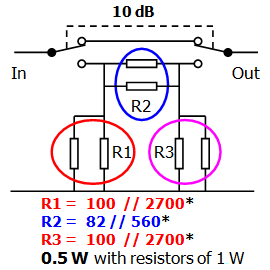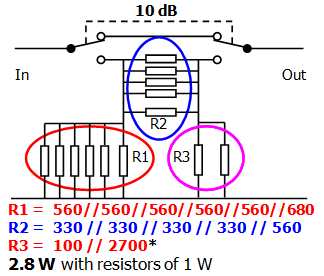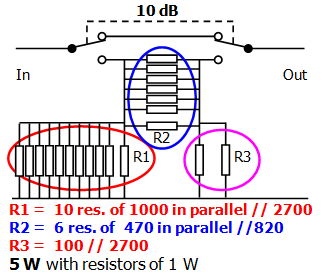PA1B Power attenuators
PA1B Accurate attenuators
The PA1B power attenuators of 50 ohm are very accurate in attenuation and in both input and output impedance.
To increase the power of the attenuator I use power resistors in parallel, so the attenuator can handle much more power. The use of resistors in parallel leads to a very simple layout.
In the PA1B Power Attenuators, I use power resistors of 1 or 2 W.
Accurate attenuators
Accurate attenuators use very precise resistor values, such as 96.25 ohm or 71.15 ohm in a 10 dB attenuator. These values are not available. But with two or more resistors from the E12-series in parallel, any value can be made.
In the PA1B Power Attenuators, I use power resistors of 1 or 2 W, so the attenuator can handle much more power. The use of resistors in parallel leads to a very simple layout.
Accurate 10 dB attenuator

Accurate 10 dB attenuator
Resistors with star can be 1/4 W
Power distribution
This schematic shows the power distribution in a 10 dB attenuator with a nominal power of 5 watt.

Power distribution – Input power 5 watt
A attenuators can dissipate the nominal power for a long time. But without cooling, the resistors of your attenuator will get very hot, when you unleash the maximum power for a longer time.
Accurate 10 dB power attenuator
Here is the schematic of a 10 dB attenuator for a nominal power of 5 watt.
To avoid overheating, the attenuator is designed for a maximum power of 20 watt.
With a chosen derating of D = 0.25, the maximum power is 4 time as high as the nominal power.
The power is dissipated by power resistors in parallel.

Accurate 10 dB power attenuator Nominal power 5 W with resistors of 1 W
The compound resistor R1 consists of 11 power resistors of 1 watt in parallel, to form a very accurate power resistor of 96.25 ohm, with a nominal power of 2.6 watt.
Simple layout
The choice of placing resistors in parallel, leads to a very simple layout of the attenuator sections. There’s NO need for a PCB. hi.
Power
Although all sections are designed for a power of nominal power of 1,5 W (6 W max), this line up is the best to distribute the input power over the sections. To reduce the number of resistors, I chose to use good available (metal film) resistors of 2 watts. Please notice that the resistors with a star can be 250 mW resistors. All attenuator sections are designed for an maximum input power of 6 watts. This power can only be used for about 20 seconds. Without cooling the resistors will get hot in a short while.
Accuracy
With two or more resistors from the E12-series in parallel, any value can be made accurately. In practice the accuracy of the resistors will be about 2%, so the accuracy of the attenuator is very good. The resistor value of the combination is most of the time within 1% of the theoretical value. The measured accuracy of the 20 dB attenuator sections is 0.1 dB. The other sections are even more accurate.
Fast in QSO’s
A simple way to reduce the power of your QRP set to milliwatt level, without modifying the set, is the use of attenuators. The combination of 3 dB, 7 dB, 10 dB and 20 dB is fast to switch, when you want to increase your power in QSO’s. In one move, one attenuator section is switched OFF and an other is switched ON, to increase the power with a step of 3 db or 4 dB.
10 dB Power Attenuators
The 10 dB attenuators shown here, are all built with good available 1 W resistors of the E12-series. Each of the 4 attenuators is designed for a different value of input power. They cover the power spectrum from 500 mW to 5 watts.
The higher the input power the more resistors are needed. The power of each attenuator is the nominal power.
In the design of the Power Attenuator on this website, I have chosen a Derating of 25 %. this means that the nominal power is 1/4 of the Maximum Power. Or the Maximum power is 4 times the Nominal power.
and with no cooling of the resistors, they will easily become hot in a short while.

10 dB Attenuator for 1.6 W
with resistors of 1W

10 dB Attenuator for 0.5 W
with resistors of 1W
The basic 10 dB attenuator consists of 6 resistors and is good for a maximum input power of 500 mW – 2 W max.
The attenuators are built with resistor of 1 W. The resistors that are designated with a star* (e.g. 2700*) can be resistor 1/4 W.
The attenuator that is built with 9 resistors is suitable for 1.6 W. This is a maximum power of 6.4 W.
The attenuators are built with resistor of 1 W. The resistors that are designated with a star* (e.g. 2700*) can be resistor 1/4 W.

10 dB Attenuator for 2.8 W
with resistors of 1W

10 dB Attenuator for 5 W
with resistors of 1W
With 13 resistors the attenuator is good for 2.8 W (maximum power 11.2 W).
[av_one_third min_height=” vertical_alignment=” space=” custom_margin=” margin=’0px’ link=” linktarget=” link_hover=” padding=’0px’ border=” border_color=” radius=’0px’ background=’bg_color’ background_color=” background_gradient_color1=” background_gradient_color2=” background_gradient_direction=’vertical’ src=” b
